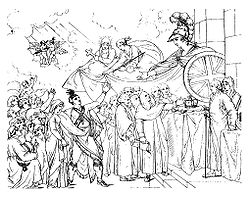This article may require cleanup to meet Wikipedia's quality standards. The specific problem is: it sucks.(August 2024) |
| Part of the American Revolution and American immigration to Canada | |
 Loyalists receiving protection from Britannia, Reception of the American Loyalists by Great Britain in the Year 1783 by Benjamin West | |
| Participants | Government of the British Empire Government of United States Loyalists (United Empire Loyalist) |
|---|---|
| Outcome | Estimated 88,400 refugees |
During the American Revolution, those who continued to support King George III of Great Britain came to be known as Loyalists. Loyalists are to be contrasted with Patriots, who supported American republicanism. Historians have estimated that during the American Revolution, between 15 and 20 percent of the white population of the colonies, or about 500000 people, were Loyalists. [1] As the war concluded with Great Britain defeated by the Americans and the French, the most active Loyalists were no longer welcome in the United States, and sought to move elsewhere in the British Empire. The large majority (about 80%–90%) of the Loyalists remained in the United States, however, and enjoyed full citizenship there.
Contents
- Origins
- Resistance of the Loyalists
- Attacks on Royal officials and Loyalists
- Resettlement
- Great Britain
- British North America
- References
- Further reading
- External links
- 61,000 White loyalists (who also had 17,000 slaves)
- 3,500 free Black loyalists emigrate to Canada.
- 2,000 enslaved Blacks are taken to Canada
- 42,000 Whites emigrate to Canada
- 3,400 Native Iroquois emigrate to Canada
- 7,000 Whites emigrate to Britain
- 5,000 free Blacks emigrate to Britain
- 12,000 Whites emigrate to Florida or the Caribbean
- 6,500 enslaved Blacks are taken to Florida
Jasanoff (2012) estimates that a total of 60000 white settlers left the new United States. The majority of them—about 33000 —went to Nova Scotia (14000 of these to what would become New Brunswick), 6,600 went to Quebec (which at the time included modern-day Ontario), and 2000 to Prince Edward Island. About 5000 white Loyalists went to Florida (then a Spanish Possession), bringing along their slaves who numbered about 6,500. About 7000 Whites and 5000 free Blacks went to Britain. [2] A recent study increases the estimate to the traditional figure of 100000 . [3]
The departing Loyalists were offered free land in British North America. Many were prominent colonists whose ancestors had originally settled in the early 17th century, while a portion were recent settlers in the Thirteen Colonies with few economic or social ties. Many had their property confiscated by Patriots. [4] A later wave of roughly 30000 Americans, who came to be known as 'Late Loyalists' were lured by the promise of land upon swearing loyalty to the King and voluntarily moved to Ontario in the 1790s into the first decade of the 1800s. Unlike that of the first group of 'refugee' Loyalists, this later group's perceived "loyalty" is a topic which remains in historical debate. Many of these later Loyalists came to oppose and became the most ardent opposition to the staunch Toryism which was exercised by the ruling class in the new colony. [5]
Loyalists resettled in what was initially the Province of Quebec (including modern-day Ontario), and in Nova Scotia (including modern-day New Brunswick). Their arrival marked the arrival of an English-speaking population in the future Canada west and east of the Quebec border. Many Loyalists from the American South brought their slaves with them as slavery was also legal in Canada. An imperial law in 1790 assured prospective immigrants to Canada that their slaves would remain their property. However more black Loyalists were free, having been given their freedom from slavery by fighting for the British or joining British lines during the Revolution. The government helped them resettle in Canada as well, transporting nearly 3,500 free blacks to New Brunswick. [6]




















